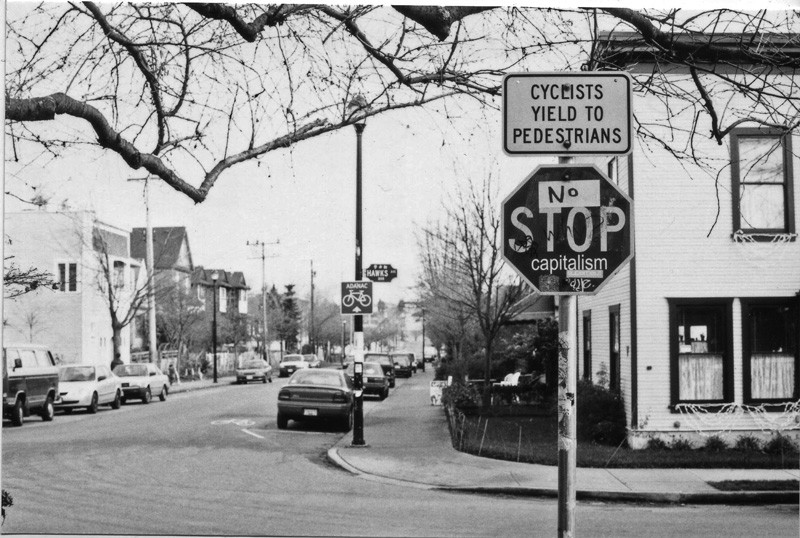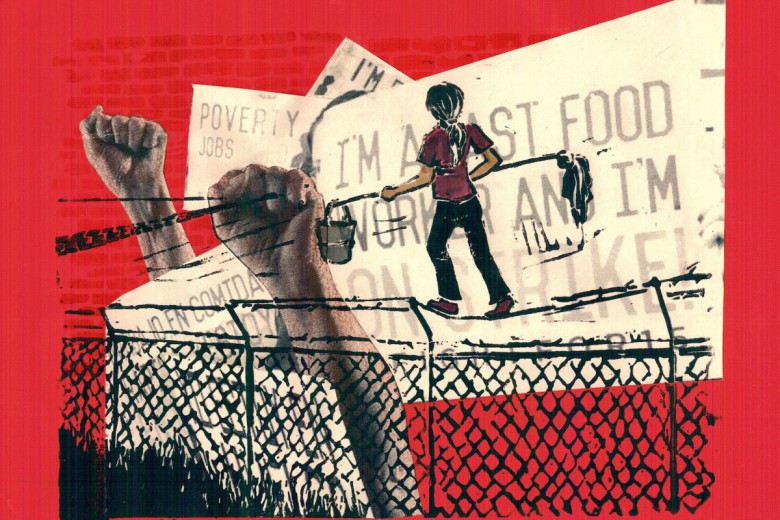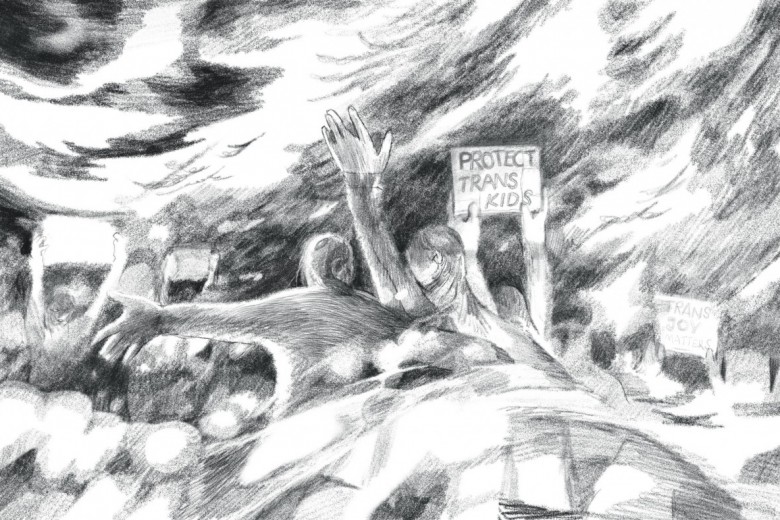
STOP eating meat. STOP driving. STOP bush junior. No, I’m not trying to tell you what to do with your life. But somebody is.
I’m referring to those stop signs upon which stickers have been stuck to instruct people to change their behaviour in some (usually socially conscious) way. Not only does this sticker art add some humour and local colour to the streets upon which it appears; it also provides a vehicle for alternative political views to be voiced.
In Vancouver, where I live, these stickered stop signs tend to collect along bike paths, the lower-income East Side, and pedestrian-friendly streets in general. But you don’t have to be in Vancouver to see them: I’ve personally found examples in Edmonton, Toronto, and Montréal, and have also seen photos from Fredericton, New Brunswick, and Portland, Oregon.
The messages I’ve seen range from STOP racism to local causes such as STOP Campbell (BC’s Premier Gordon Campbell), to the vegetarian call to STOP eating meat_—which is a personal favourite of mine, although I haven’t yet done so. There are also more enigmatic instructions such as _STOP holding on and STOP saving money.
So what drives this phenomenon, this act of using public signage for one’s own sticky, political purposes? Skai Fowler is a Vancouver-based artist who has worked on public art projects such as 2001’s _Big Picture/Media Interventions_—a public art project in which billboard space was purchased in order to display anti-commercial messages. Fowler sees the stickers as “guerilla art” that makes “a statement about art, public art, and the use of public space.” The stickered stop sign phenomenon definitely employs guerrilla tactics: the signs appear out of nowhere, and when one is plucked up by the city and replaced with a clean, sanctified sign, more pop up elsewhere.
The practice of slapping stickers on traffic signs to disseminate a political message is not a new idea. Rather, it emerged from a tradition of reclaiming public space for anti-consumerist or political purposes. This tradition manifests itself in the activities of billboard liberators and other media saboteurs—all of whom aim to disrupt the status quo of our culture of consumerism. All these activities could be described as “culture jamming,” a term derived from CB radio slang for the illegal interruption of radio broadcasts and appropriated by media activists seeking to inject subversive or critical ideas into the mass media environment.
Adbusters Magazine, based in Vancouver, has been a tireless champion of culture jamming since its launch in 1989. Adbusters is famous for its “subvertisements,” which take a well-known image of corporate and commercial origin and alter it to change its meaning, often in order to undermine or challenge the original meaning.
An example of Adbusters’ subvertising is their Obsession anti-ad. Mocking the fashion designer Calvin Klein’s famous black and white advertisements for perfume, the Adbusters version uses many characteristics of the original: a black and white image, the chiseled male model wearing tighty-whitey underwear, and the same title typed in the same font. But instead of looking seductively at the viewer or at an equally chiseled white female model, this model holds out the elastic of his underwear and contemplates what he sees. Immediately changing the meaning of the word “obsession,” this anti-ad not only mocks the model’s vanity and supposed obsession with penis size, it also mocks the superficiality of our cultural obsession with being sexy and attractive, and the buying of products to serve this purpose.
Another example of culture jamming can be found in the activities of San Francisco’s Billboard Liberation Front. Unlike Adbusters, whose activities, although subversive, are quite legal, the BLF are guerilla artists who illegaly deface billboards for political ends. Shortly after the Exxon Valdez oil spill in Alaska in 1989, for instance, the BLF turned a billboard advertising a radio station from reading “Hits Happen. New X-100,” into “Shit Happens—New Exxon.” Like Adbusters’ anti-ads, the BLF uses a commercially motivated image to create a new message that subverts the meaning of the original.
Both of these examples of culture jamming use artistic techniques in combination with political analysis to attack the messages of corporate media. This is what Sonia Katyal, a Fordham University law professor, calls “semiotic disobedience.” “Acts of semiotic disobedience,” Katyal explains, “actually try to disobey the meaning of the sign itself, and to redefine that meaning in the process.”
Public sticker art represents another method of reclaiming public space for self-expression. One of the most famous sticker art campaigns was originated by Frank Shepard Fairey of Rhode Island. In 1986, he created a sticker with an image of André the Giant and the text, “André the Giant has a posse.” Fairey and his design buddies began to stick these André the Giant stickers all over Rhode Island. Others saw the stickers, liked them, and then began anonymously posting the stickers themselves. They soon began appearing all over the Eastern United States, and by the 1990s they were showing up as far away as Greece and Japan. This campaign was essentially a parody of propaganda. The stickers, and the act of sticking them virtually everywhere, were designed to resemble “an advertising campaign: a campaign for a non-existent product. Fairey [mocked] the idea of branding by creating his own, fake brand, subversively using advertising techniques to elevate André the Giant’s image to iconic status” (Wikipedia).
The André sticker campaign eventually had to stop when Titan Sports, Inc. threatened to sue Fairey in 1993 for copyright infringement—something of a testament to the success of his experiment. Fairey was able to continue his work, however, by stylizing the image of André, and changed the text to “OBEY the giant!” Fairey is now a working artist who, ironically, now makes at least some of his living by selling OBEY merchandise: you can now purchase OBEY stickers from obeygiant.com for $3 and up. (The website also has dozens of photos tracking the spread of the OBEY campaign.)
The stickered stop signs seem to a combination of this type of spontaneous sticker art campaign and culture jamming. The image that the stickers subvert is one of instruction: stop signs direct traffic, and tell people what to do. Pedestrians, cyclists, and particularly drivers look to the signs for safety, and the stickers take advantage of that, making the driver look at the message of the sign, not just the sign itself. A few years ago, a website (the now-defunct anti-ignorance.net) carried images of the stickers for free downloading. I contacted the website, and received a reply from Ryan (who did not give his last name), who told me in an email, “advertisers have claimed free reign on outside space for years. One of the great things about the stop sign stickers . . . is that people involuntarily have to take in what is being said because they cannot help but look at the sign.”
The signs also speak of a community’s vitality and political awareness. Fowler believes that “the more guerilla art there is, the more it says something about our society and that there is an alternative voice.” Stop-sign sticker bandits inject anti-commercial and often humourous messages into an otherwise barren world of commercial signage, and their actions show that a part of the local community wants—and is willing to make—an alternative message heard.
Of all the sticker art I’ve seen on stop signs, the sticker that appears the most frequently is STOP driving. I have photographed five separate signs all with this same direction, in contrast to most other stickers, which have tended to appear only once. Some even elaborate on the available alternatives, telling the viewer to STOP driving. Start: walking! Biking! Using public transport! (These stickers are distributed by the World Carfree Network, and can be ordered from their website, www.worldcarfree.net/resources.)
This message in particular seems aptly placed. After all, who is the target audience for these signs but people in cars, and what are cars if not a potent symbol of consumerism? Stop signs aren’t simply on the road to give direction: they exist because they have been necessitated by our use of the automobile. These stickers question the message that the original sign itself carries, as well as the laws behind the original message. They question the need to be driving and the laws and incentives that have helped make private automobiles the dominant form of transportation in North America.
The questions raised by this sticker art point to the prevalent use of the automobile in North America. Why do we accept our dependency on private automobiles as normal? After all, most places on the planet don’t use cars as much as we do. One answer to this question lies in the fact that the private use of automobiles has been heavily subsidized by governments since it first gained popular use, because governments (and by extension, all of us) shouldered the costs of building roads, highways, and traffic lights, furthering the convenience of car use. All the car companies had to provide was the car.
Not only do we subsidize private automobile use, we also overuse cars: typically, the sale of new cars rises at a greater rate in Canada than that of the human population. For example, the first half of 2007 saw a 6.9 percent increase in car sales in the country as a whole. By contrast, Canada’s human population rose 1.0 percent from 2006 to 2007. Also, the average car makes 2,000 trips of three kilometres or less every year, a distance easily covered by cycling or walking. All this results in increased health risks due to air pollution, longer travel times due to traffic congestion, and economies drained because of incomes increasingly diverted to automobile use and maintenance. STOP driving, indeed.
These stickered stop signs call into question the very traffic signs upon which they appear, and mock our numb obedience to car culture itself. The stickers then create a new command out of the stop sign, and elevate the sign to a political, self-reflexive message.
So what happens to these fine examples of political sticker art once they’ve been discovered? In Vancouver, they are considered graffiti, and are therefore illegal. Ms. Fowler explains that graffiti is defined as “anything that’s not a mural. There’s an anti-graffiti law in Vancouver. If a building has graffiti on it, the owner or shop keeper gets fined.” Although the City of Vancouver can’t exactly fine itself for graffiti found on its own property, it does have to spend the money to keep the signs pristine. I spoke with Dan Elford in the Traffic Signals and Street Signs Department in the City of Vancouver’s Public Works. I asked him what the common practice is when city workers come across stickered signs. As far as stickers of a political nature go, Dan told me, “If it’s not offensive, we leave it be. If it is, we replace it.” He also observed that “stickered signs appear during political events,” indicating again that there is no one person or organization stickering the signs, but rather, the political climate itself becomes the catalyst. I have noticed that most stickered signs get replaced rather promptly. Many of the signs I’ve photographed have been replaced. However, one sign, “STOP smoking,” on East 7th Ave. and Québec St., has managed to remain in public view for nearly four years. I imagine this inconsistency in maintenance results from the degree of controversy in the stickered sign, the sense of humour of the city workers, and the character of the surrounding neighbourhood.
But just how effective are these sticker art campaigns? They are clever, yes, but, as I mentioned before, the signs tend to proliferate in areas where political activism is popular anyway, so one might wonder if the perpetrators are simply preaching to the converted. “I think [a stickered sign’s] success,” says Skai Fowler, “is measured by the number of people that comment on it, or that think about it.” But since it’s rather hard to track that, perhaps the stickers’ success is best measured by the recurrence of the phenomenon. As I mentioned, many of the stickered signs that I photographed three years ago have since been taken down. However, I have seen new, different stickered signs crop up since then. Clearly, the torch has been passed on.
As a post script, I recently found a website that carries what it calls “counter-hippie” stop sign stickers. “The hippies think they’re so clever,” declares www.glarkware.com, “defacing stop signs with messages heckling us to STOP Driving or STOP Eating Animals. Wouldn’t you like to stick it to them (literally) with your own set of stickers?” Some of the stickers the site carries are STOP Hammertime! and STOP defacing stop signs. I think it’s safe to say that when something becomes the target of parody, it has garnered a certain level of success.
Michelle Deines is a writer and teacher living in Vancouver, BC. She has never put a sticker on a stop sign. Honest.





